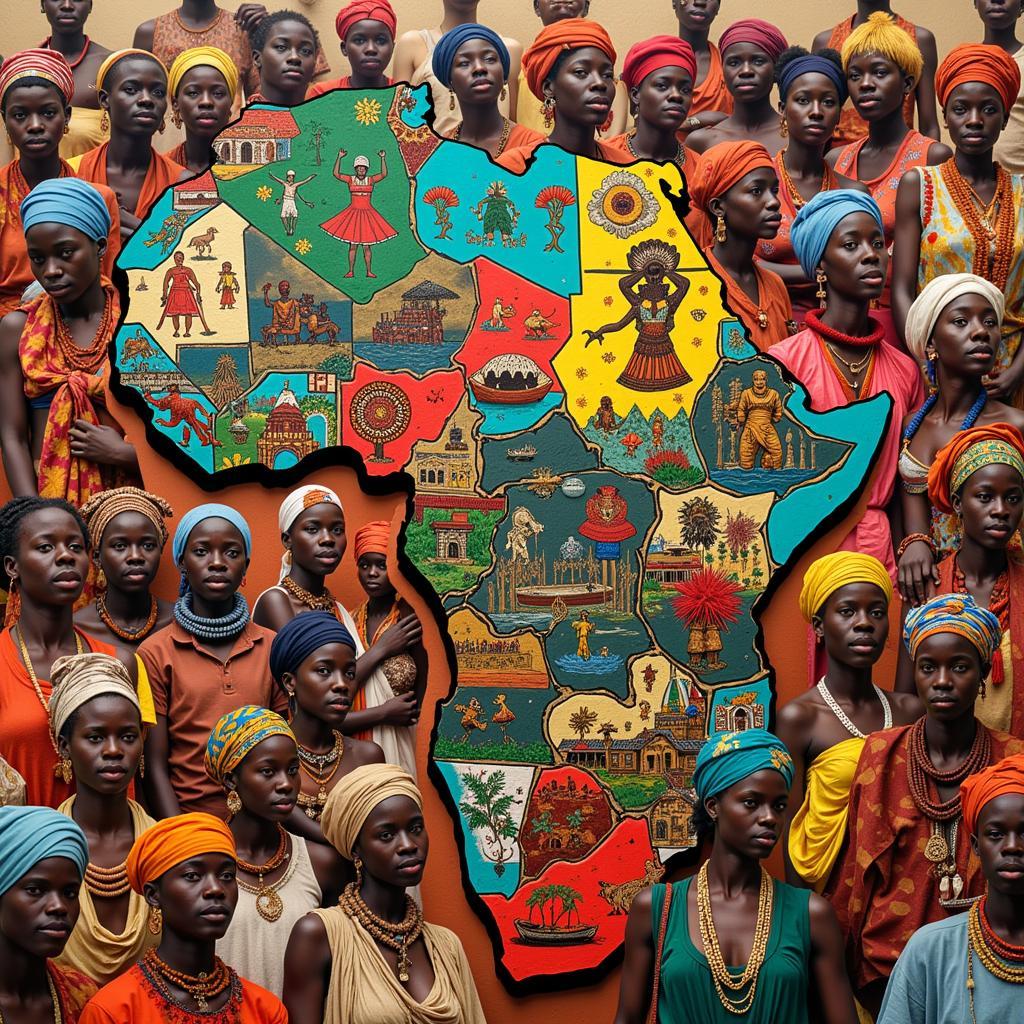African Attire Details: A Journey Through Style, Culture, and Tradition
African attire is a vibrant tapestry woven from threads of history, culture, and tradition. The continent’s diverse people express themselves through clothing, showcasing unique details that tell stories of heritage and identity. This exploration delves into the intricate world of African Attire Details, uncovering the meaning behind the patterns, fabrics, and adornments.
Unraveling the Threads: The Significance of Details in African Attire
More than just garments, African attire embodies social status, marital status, ethnicity, and religious beliefs. Every detail, from the cut and color to the embellishments and accessories, carries meaning.
The Language of Colors: A Spectrum of Symbolism
Color plays a pivotal role in African attire, often conveying profound messages. For instance, red, often associated with power and vitality, features prominently in Maasai warrior attire. White, symbolizing purity and spirituality, is often worn during ceremonies and rituals.
Fabric Tales: Weaving Stories into Cloth
Traditional African attire utilizes a variety of fabrics, each with its own story. Handwoven kente cloth from Ghana, with its intricate geometric patterns, signifies wealth and status. Mud cloth from Mali, dyed with fermented mud and plant extracts, showcases ancient techniques passed down through generations.
A Glimpse into Regional Styles: Highlighting Unique Details
West Africa: A Fusion of Bold Prints and Flowing Silhouettes
West African attire is renowned for its vibrant colors, bold prints, and flowing silhouettes. The boubou, a long, flowing robe worn by both men and women, exemplifies the region’s elegant drapery. Intricate embroidery and embellishments often adorn these garments, reflecting cultural motifs and personal style.
East Africa: A Tapestry of Cultural Influences
East African attire reflects a blend of Arabic, Indian, and indigenous influences. The kanga, a rectangular cloth adorned with Swahili proverbs and vibrant patterns, is a staple in Tanzania and Kenya. Worn as a skirt, headscarf, or baby carrier, the kanga exemplifies practicality and cultural expression.
Southern Africa: Celebrating Beadwork and Animal Hide
Southern African attire showcases the region’s rich tradition of beadwork and the use of animal hides. The intricate beadwork of the Ndebele people of South Africa, with its geometric patterns and vibrant colors, is world-renowned. Leather garments, often adorned with beads or metalwork, reflect the region’s historical connection to cattle herding.
Modern Adaptations: African Attire in the Contemporary World
African attire continues to evolve, with designers drawing inspiration from traditional styles while incorporating modern aesthetics. Runway shows across the globe showcase the beauty and versatility of African fabrics and designs, redefining perceptions and celebrating cultural heritage.
Conclusion: Embracing the Rich Tapestry of African Attire
Exploring the details of African attire unveils a world of cultural significance and artistic expression. From the vibrant colors to the intricate patterns, each element tells a story, connecting the present to the past and celebrating the diverse heritage of the continent. This journey through the details of African attire is an invitation to appreciate the beauty, creativity, and profound cultural significance embedded in every thread.
FAQ
What are some common fabrics used in African attire?
African attire utilizes various fabrics like kente cloth, mud cloth, Aso Oke, Ankara, and Kitenge. Each fabric holds cultural significance and reflects unique weaving techniques.
What is the significance of beadwork in African attire?
Beadwork in African attire, particularly in Southern Africa, holds deep cultural significance, often signifying social status, age, and marital status. Each color and pattern combination can convey specific messages and meanings.
How has African attire influenced contemporary fashion?
African attire has significantly influenced contemporary fashion, inspiring designers worldwide to incorporate vibrant prints, bold colors, and unique silhouettes into their collections. It has led to greater appreciation for African craftsmanship and cultural heritage.
Do you have other questions about African attire?
Here are some other topics you might find interesting:
- The History and Evolution of African Headwraps
- The Art of Adornment: Jewelry and Accessories in African Culture
- Sustainable Fashion: Contemporary African Designers Championing Ethical Practices
For any further assistance or information, please don’t hesitate to contact us:
Phone Number: +255768904061
Email: kaka.mag@gmail.com
Address: Mbarali DC Mawindi, Kangaga, Tanzania
We have a dedicated customer support team available 24/7 to assist you.


